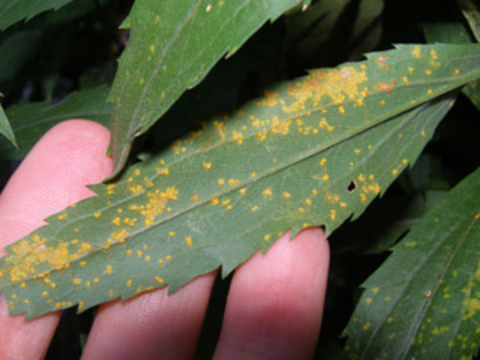Quick facts
-
Pine needle rust discolors needles and slows tree growth of young pines with 2 or 3 needles per bundle.
-
The pine needle rust fungus needs two different host plants to complete its life cycle. One plant from the Pine family and the other from the Aster family.
-
Management is rarely required because needle rust does very little overall harm to well-established trees.
How to identify Pine needle rust
Symptoms on host plants in Pinaceae
Yellow-to-orange spots or bands appear on green needles in spring. Needles turn partly or completely yellow.
In late spring to early summer, tiny, raised, white tubes form on needles breaking open to release powdery, orange spores.
Infected needles may remain attached for several years.
Severe infection causes needles to die, turn brown and fall off.
Lower branches of young trees are most severely affected.
Symptoms on host plants in Asteraceae
Infected leaves develop yellow leaf spots on the upper leaf surface and raised orange spore-filled pustules on the lower leaf surface.
Powdery, yellow-orange spores are produced on the lower leaf surface all summer long.
Dark brown spores appear within leaf spots on the lower leaf surface in late summer and fall.
Plants affected by Pine needle rust in Minnesota
Pines
Austrian pine (Pinus nigra)
Jack pine (P. bankisana)
Red pine (P. resinosa)
Ponderosa pine (P. ponderosa)
Mugo pine (P. mugo)
Scots pine (P. sylvestris)
Asters
Most commonly affected:
Aster (Aster spp.)
Goldenrod (Solidago spp.)
Occasionally affected:
Daisy fleabane (Erigeron spp.)
Gumweed (Grindelia spp.)
Goldenaster (Heterotheca spp.)
How does Pine needle rust survive and spread?
Pine needle rust is caused by the fungus Coleosporium asterum. Like many rust fungi, C. asterum needs two different host plants to complete its life cycle. One plant from the Pinaceae family and the other from the Asteraceae family.
The needle rust fungus creates multiple, unique types of spores that all play a different role in this complex life cycle and allow it to move between pine trees and plants in the aster family.
All of these spore types need moisture on leaves and needles to start a new infection.
The needle rust fungus survives winter within living plant tissue including infected pine needles and infected leaves at the crown of plants in the aster family.
Yellow-to-orange, spore producing structures appear as spots or bands on infected pine needles in early spring.
By early summer, white, tube-like structures rise from the spots and produce spores. These structures split open and release powdery, orange spores.
The spores produced on pine needles cannot re-infect other pine needles. Instead, they are carried by wind to infect the leaves of a susceptible member of the aster family.
Infected leaves of plants in the aster family produce powdery, yellow-orange spores on the lower leaf surface all summer long.
These spores can only re-infect another member of the aster family and cannot infect pine needles.
In fall, a different, dark brown spore type is formed on the aster. These spores are carried by wind to infect nearby pine needles.
How to manage Pine needle rust
Pine needle rust is a minor stress on the tree and no management is required.
Increase the vigor of infected trees by watering during dry conditions and mulching to conserve water.
Removal of alternative hosts such as wild or cultivated species of aster (Aster), goldenrod (Solidago) and several other members of the daisy or aster family (Asteraceae) from the immediate area of the trees will reduce infections of pines.
In areas with large numbers of wild asters, plant conifers resistant to needle rusts like spruce, white pine or balsam fir.
Reviewed in 2024



